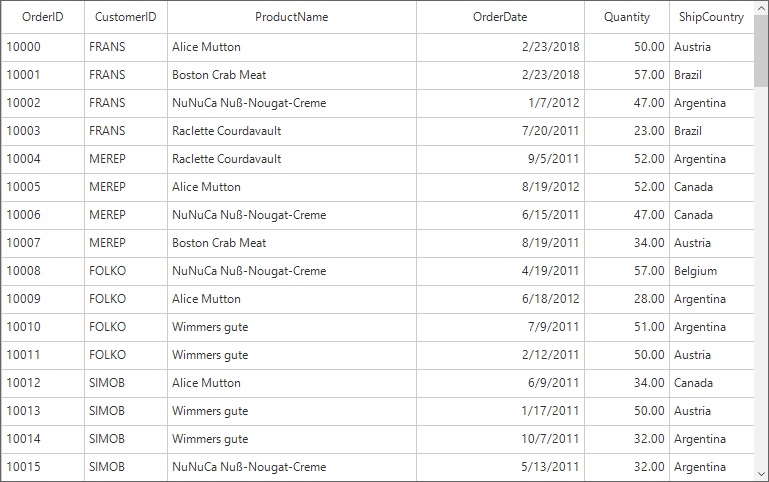Columns in WinForms DataGrid (SfDataGrid)
21 Jan 202524 minutes to read
SfDataGrid allows to add or remove columns using SfDataGrid.Columns property. The columns to be added can be chosen from built-in column types or own column can be created and add to the SfDataGrid.Columns.
Below are the built-in column types supported in SfDataGrid. Each column has its own properties to handle different types of data.
|
Column Type |
Description |
| Use to display the string data | |
| Use to display the numeric data | |
| Use to display the date time value | |
| Use to display the Boolean type data | |
| Use to display combobox in each row | |
| Use to display the image in each row | |
| Use to display the Uri data | |
| Use to display button in each row | |
| Use to display progressbar in each row | |
| Use to display multi select combobox in each row | |
| Use to display the masked value. | |
| Selects or deselects rows based on the check box value, which is not bound with data object. |
Defining Columns
SfDataGrid provides support for creating columns automatically or manually. Below sections explains both the ways,
SfDataGrid provides support for generating
- Automatically generating columns
- Manually defining columns
Automatically Generating Columns
The automatic column generation based on properties of data object can be enabled or disabled by setting SfDataGrid.AutoGenerateColumns. Default value is true. The columns will be automatically generated based on its column type from the underlying data source.
It is also possible to generate columns for custom type properties in the data object by setting the SfDataGrid.AutoGenerateColumnsForCustomType property to true. The default value is false.
|
Data Type |
Column |
| string, object, dynamic | GridTextColumn |
| int, float, double, decimal and also it’s nullable | GridNumericColumn |
| DateTime, DateTimeOffset and also it’s nullable | GridDateTimeColumn |
| Uri, Uri? | GridHyperLinkColumn |
| bool, bool? | GridCheckBoxColumn |
NOTE
The order of columns in the collection will determine the order of that they will appear in SfDataGrid.
AutoGenerateColumns with Different Modes
The column auto generation is controlled using the SfDataGrid.AutoGenerateColumnsMode property. Default value is AutoGenerateColumnsMode.Reset.
The SfDataGrid.AutoGenerateColumnsMode includes the following modes.
|
Mode |
Behavior |
When DataSource changed |
| None | Generates the columns based on the explicit column definition. | Keeps old columns in DataGrid.Columns collection. |
| Reset | Generates the columns based on the properties defined in the underlying data object and explicit column definition. | Keeps the columns added manually. Clears the columns which are auto generated before and creates new columns based on new DataSource. |
| ResetAll | Generates the columns based on the properties defined in the underlying data object. | Clear all the columns including the columns defined manually and creates new columns based on new DataSource. |
| RetainOld | Generates the columns based on the properties defined in the underlying data object, when the SfDataGrid doesn’t have an explicit column definition. | The same columns will be maintained when changing DataSource also. So sorting and grouping settings will be maintained. |
| SmartReset | Generates the columns and retains data operation based on the properties defined in underlying data object. | Keeps the columns which matches in the current data source and the data operation performed in it. |
Auto generating columns for complex type
Custom type (complex type) properties in the data object can be auto-generated by setting the AutoGenerateColumnsForCustomType property as true. The default value is false.
Custom type properties will be auto-generated through the AutoGenerateColumnsModeForCustomType property.
this.sfDataGrid1.AutoGenerateColumnsForCustomType = true;
this.sfDataGrid1.AutoGenerateColumnsModeForCustomType = AutoGenerateColumnsModeForCustomType.Parent;Me.sfDataGrid1.AutoGenerateColumnsForCustomType = True
Me.sfDataGrid1.AutoGenerateColumnsModeForCustomType = AutoGenerateColumnsModeForCustomType.ParentThe AutoGenerateColumnsModeForCustomType includes the following modes.
| Mode | Behavior |
|---|---|
Child
|
Specifies that the columns for all inner properties of the custom type column will be auto-generated. |
Parent
|
Specifies that the column for only the custom type will be auto-generated. |
Both
|
Specifies that the columns for both the custom type and its inner properties will be auto generated. |
Customize Auto-generated Columns
The auto-generated column can be customized by handling the AutoGeneratingColumn event. The AutoGeneratingColumn event occurs when the column is auto-generated.
AutoGeneratingColumnArgs provides the information about the auto-generated column to the AutoGeneratingColumn event. AutoGeneratingColumnArgs.Column property returns the auto-generated column.
this.sfDataGrid1.AutoGeneratingColumn += SfDataGrid1_AutoGeneratingColumn;
private void SfDataGrid1_AutoGeneratingColumn(object sender, AutoGeneratingColumnArgs e)
{
e.Column.HeaderText = "AutoGenerated";
e.Column.HeaderStyle.BackColor = Color.LightSkyBlue;
}AddHandler sfDataGrid1.AutoGeneratingColumn, AddressOf SfDataGrid1_AutoGeneratingColumn
Private Sub SfDataGrid1_AutoGeneratingColumn(ByVal sender As Object, ByVal e As AutoGeneratingColumnArgs)
e.Column.HeaderText = "AutoGenerated"
e.Column.HeaderStyle.BackColor = Color.LightSkyBlue
End SubCancel Column Generation for Particular Property
The auto generation of the specific column can be canceled by handling the AutoGeneratingColumn event. The column generation can be canceled by setting the Cancel property to true.
this.sfDataGrid1.AutoGeneratingColumn += SfDataGrid1_AutoGeneratingColumn;
private void SfDataGrid1_AutoGeneratingColumn(object sender, AutoGeneratingColumnArgs e)
{
if (e.Column.MappingName == "OrderID")
e.Cancel = true;
}AddHandler sfDataGrid1.AutoGeneratingColumn, AddressOf SfDataGrid1_AutoGeneratingColumn
Private Sub SfDataGrid1_AutoGeneratingColumn(ByVal sender As Object, ByVal e As AutoGeneratingColumnArgs)
If e.Column.MappingName = "OrderID" Then
e.Cancel = True
End If
End SubChanging Column Type
The type of column adding to SfDataGrid can be changed by setting the instance of column that has to be added in AutoGeneratingColumn event.
In the below code, column type for UnitPrice property is changed to GridTextColumn by setting instance of GridTextColumn to Column property.
this.sfDataGrid1.AutoGeneratingColumn += SfDataGrid1_AutoGeneratingColumn;
private void SfDataGrid1_AutoGeneratingColumn(object sender, AutoGeneratingColumnArgs e)
{
if (e.Column.MappingName == "UnitPrice")
{
if (e.Column is GridNumericColumn)
{
e.Column = new GridTextColumn() { MappingName = "UnitPrice", HeaderText = "Unit Price" };
}
}
}AddHandler sfDataGrid1.AutoGeneratingColumn, AddressOf SfDataGrid1_AutoGeneratingColumn
Private Sub SfDataGrid1_AutoGeneratingColumn(ByVal sender As Object, ByVal e As AutoGeneratingColumnArgs)
If e.Column.MappingName = "UnitPrice" Then
If TypeOf e.Column Is GridNumericColumn Then
e.Column = New GridTextColumn() With {.MappingName = "UnitPrice", .HeaderText = "Unit Price"}
End If
End If
End SubChanging Property Settings
The properties of the auto generating column can be changed by handling the AutoGeneratingColumn event.
this.sfDataGrid1.AutoGeneratingColumn += SfDataGrid1_AutoGeneratingColumn;
private void SfDataGrid1_AutoGeneratingColumn(object sender, AutoGeneratingColumnArgs e)
{
if (e.Column.MappingName == "OrderID")
{
e.Column.AllowSorting = true;
e.Column.AllowGrouping = false;
e.Column.HeaderStyle.BackColor = Color.LightSkyBlue;
e.Column.CellStyle.BackColor = Color.MediumBlue;
}
}AddHandler sfDataGrid1.AutoGeneratingColumn, AddressOf SfDataGrid1_AutoGeneratingColumn
Private Sub SfDataGrid1_AutoGeneratingColumn(ByVal sender As Object, ByVal e As AutoGeneratingColumnArgs)
If e.Column.MappingName = "OrderID" Then
e.Column.AllowSorting = True
e.Column.AllowGrouping = False
e.Column.HeaderStyle.BackColor = Color.LightSkyBlue
e.Column.CellStyle.BackColor = Color.MediumBlue
End If
End SubData Annotations with AutoGenerateColumns
SfDataGrid support to generate the columns based on built-in Data Annotation Attributes. Data Annotations ignored, when the AutoGenerateColumns is set to false.
Exclude Column
The column generation can be skipped by using AutoGenerateField property or by setting the Bindable attribute to false.
[Display(AutoGenerateField = false, Description = "OrderID field is not generated in UI")]
public int OrderID
{
get { return orderID; }
set { orderID = value; }
}<Display(AutoGenerateField := False, Description := "OrderID field is not generated in UI")>
Public Property OrderID() As Integer
Get
Return orderID
End Get
Set(ByVal value As Integer)
orderID = value
End Set
End PropertyFiltering
Filtering can be enabled automatically for the field by using Display.AutoGenerateFilter property
[Display(AutoGenerateFilter = true, Description = "Filter enabled for CustomerID column")]
public string CustomerID
{
get { return customerId; }
set { customerId = value; }
}<Display(AutoGenerateFilter := True, Description := "Filter enabled for CustomerID column")>
Public Property CustomerID() As String
Get
Return customerId
End Get
Set(ByVal value As String)
customerId = value
End Set
End PropertyEditing
The value of the property can be changed by using Editable attribute.
[Editable(true)]
public string Country
{
get { return country; }
set { country = value; }
}<Editable(True)>
Public Property Country() As String
Get
Return country
End Get
Set(ByVal value As String)
country = value
End Set
End PropertyChange the HeaderText of Column
The Header text of column can be customized by using Display.Name property.
[Display(Name="Name of the Customer",Description="CustomerName is necessary for identification ")]
public string CustomerName
{
get { return customerName; }
set { customerName = value; }
}<Display(Name:="Name of the Customer",Description:="CustomerName is necessary for identification ")>
Public Property CustomerName() As String
Get
Return customerName
End Get
Set(ByVal value As String)
customerName = value
End Set
End PropertyChange the Order of the Columns
The columns order can be changed by using DisplayAttribute.Order property.
[Display(Order=0)]
public int OrderID
{
get { return orderID; }
set { orderID = value; }
}
[Display(Order=-1)]
public string CustomerID
{
get { return customerId; }
set { customerId = value; }
}<Display(Order:=0)>
Public Property OrderID() As Integer
Get
Return orderID
End Get
Set(ByVal value As Integer)
orderID = value
End Set
End Property
<Display(Order:=-1)>
Public Property CustomerID() As String
Get
Return customerId
End Get
Set(ByVal value As String)
customerId = value
End Set
End PropertyThe OrderID and CustomerID column rearranged based on specified order.

Customizing Data Format
The data format can be customized using DataTypeAttribute.DataType property.
[DataType(DataType.Currency)]
public double UnitPrice
{
get { return unitPrice; }
set { unitPrice = value; }
}<DataType(DataType.Currency)>
Public Property UnitPrice() As Double
Get
Return unitPrice
End Get
Set(ByVal value As Double)
unitPrice = value
End Set
End PropertySetting Read-only Column
The editing for a column can be disabled by using ReadOnly attribute..
[ReadOnly(true)]
public string Country
{
get { return country; }
set { country = value; }
}<ReadOnly(True)>
Public Property Country() As String
Get
Return country
End Get
Set(ByVal value As String)
country = value
End Set
End PropertyManually Defining Columns
The SfDataGrid allows to define the columns manually by adding the desired column to the SfDataGrid.Columns collection.
this.sfDataGrid1.AutoGenerateColumns = false;
this.sfDataGrid1.DataSource = collection.OrdersListDetails;
this.sfDataGrid1.Columns.Add(new GridTextColumn() { MappingName = "OrderID", HeaderText = "Order ID" });
this.sfDataGrid1.Columns.Add(new GridTextColumn() { MappingName = "CustomerID", HeaderText = "Customer ID" });
this.sfDataGrid1.Columns.Add(new GridTextColumn() { MappingName = "CustomerName", HeaderText = "Customer Name" });
this.sfDataGrid1.Columns.Add(new GridTextColumn() { MappingName = "Country", HeaderText = "Country" });
this.sfDataGrid1.Columns.Add(new GridTextColumn() { MappingName = "ProductName", HeaderText = "Product Name" });Me.sfDataGrid1.AutoGenerateColumns = False
Me.sfDataGrid1.DataSource = collection.OrdersListDetails
Me.sfDataGrid1.Columns.Add(New GridTextColumn() With {.MappingName = "OrderID", .HeaderText = "Order ID"})
Me.sfDataGrid1.Columns.Add(New GridTextColumn() With {.MappingName = "CustomerID", .HeaderText = "Customer ID"})
Me.sfDataGrid1.Columns.Add(New GridTextColumn() With {.MappingName = "CustomerName", .HeaderText = "Customer Name"})
Me.sfDataGrid1.Columns.Add(New GridTextColumn() With {.MappingName = "Country", .HeaderText = "Country"})
Me.sfDataGrid1.Columns.Add(New GridTextColumn() With {.MappingName = "ProductName", .HeaderText = "Product Name"})Column Manipulation
The columns (added or auto-generated) can be retrieved from SfDataGrid.Columns property.
Adding Column
The column can be added to the SfDataGrid by adding the instance of the column to SfDataGrid.Columns property.
this.sfDataGrid1.Columns.Add(new GridTextColumn() { MappingName = "OrderID", HeaderText = "Order ID" });Me.sfDataGrid1.Columns.Add(New GridTextColumn() With {.MappingName = "OrderID", .HeaderText = "Order ID"})Accessing Column
The column can be accessed through its column index or GridColumnBase.MappingName property from the SfDataGrid.Columns collection.
GridColumn column = this.sfDataGrid1.Columns[1];
// Or
GridColumn column = this.sfDataGrid1.Columns["OrderID"];Dim column As GridColumn = Me.sfDataGrid1.Columns(1)
' Or
Dim column As GridColumn = Me.sfDataGrid1.Columns("OrderID")Clearing or Removing Column
All the columns can be removed by clearing the SfDataGrid.Columns collection.
this.sfDataGrid1.Columns.Clear();Me.sfDataGrid1.Columns.Clear()A column can be removed using the Remove and RemoveAt methods.
this.sfDataGrid1.Columns.Remove(gridColumn);
// Or
this.sfDataGrid1.Columns.RemoveAt(1);Me.sfDataGrid1.Columns.Remove(gridColumn)
' Or
Me.sfDataGrid1.Columns.RemoveAt(1)Column under a stacked column can be removed from StackedHeaderRow.
var childColumns = this.sfDataGrid1.StackedHeaderRows[0].StackedColumns[0].ChildColumns.Split(',');
foreach(var name in childColumns)
{
var column = this.sfDataGrid1.Columns[name];
this.sfDataGrid1.Columns.Remove(column);
}Dim childColumns = Me.sfDataGrid1.StackedHeaderRows(0).StackedColumns(0).ChildColumns.Split(","c)
For Each name In childColumns
Dim column = Me.sfDataGrid1.Columns(name)
Me.sfDataGrid1.Columns.Remove(column)
Next nameChanging the order of a column
The order of a column can be changed by using the SfDataGrid.Columns.Move method.
sfDataGrid.Columns.Move(0, 5);sfDataGrid.Columns.Move(0, 5)Resizing Columns
SfDataGrid allows to resize the columns like in excel by resizing column header.
This can be enabled or disabled by setting SfDataGrid.AllowResizingColumns
or GridColumnBase.AllowResizing property.
NOTE
Resizing considers MinimumWidth and MaximumWidth of column.
this.sfDataGrid1.AllowResizingColumns = true;Me.sfDataGrid1.AllowResizingColumns = TrueThe column width can be changed by clicking and dragging the resizing cursor at the edge of column header. The resizing cursor appears when you hover the line exists between two columns.
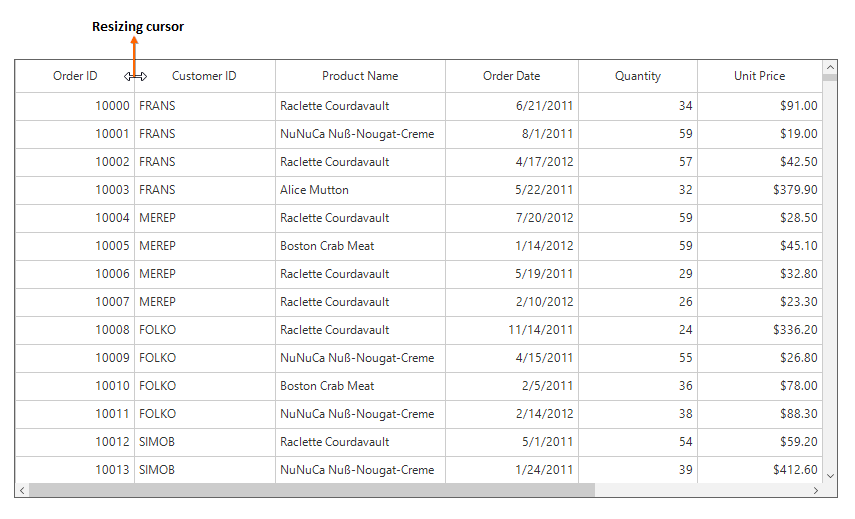
Hidden Column Resizing
SfDataGrid shows indication for hidden columns in column header and also allows end-users to resize the hidden columns when setting SfDataGrid.AllowResizingHiddenColumns property to true.

Disable Resizing
Resizing of particular column can be canceled by setting GridColumnBase.AllowResizing property to false.
In another way, the resizing can be canceled by handling SfDataGrid.ColumnResizing event. The ColumnResizing event occurs when start dragging by resizing cursor on headers.
ColumnResizingEventArgs of ColumnResizing provides information about the column’s index and width.
this.sfDataGrid.ColumnResizing += SfDataGrid_ColumnResizing;
void SfDataGrid_ColumnResizing(object sender, ColumnResizingEventArgs e)
{
if (e.ColumnIndex == 1)
e.Cancel = true;
}AddHandler sfDataGrid.ColumnResizing, AddressOf SfDataGrid_ColumnResizing
Private Sub SfDataGrid_ColumnResizing(ByVal sender As Object, ByVal e As ColumnResizingEventArgs)
If e.ColumnIndex = 1 Then
e.Cancel = True
End If
End SubHiding Columns
You can hide any column in SfDataGrid by using GridColumnBase.Visible property. Refer to the following code example.
this.sfDataGrid.Columns["ProductName"].Visible = false;Me.sfDataGrid.Columns("ProductName").Visible = False
Column Drag and Drop
SfDataGrid allow end-users to rearrange the columns by drag and drop the column headers by setting SfDataGrid.AllowDraggingColumns to true.
sfDataGrid.AllowDraggingColumns = true;sfDataGrid.AllowDraggingColumns = True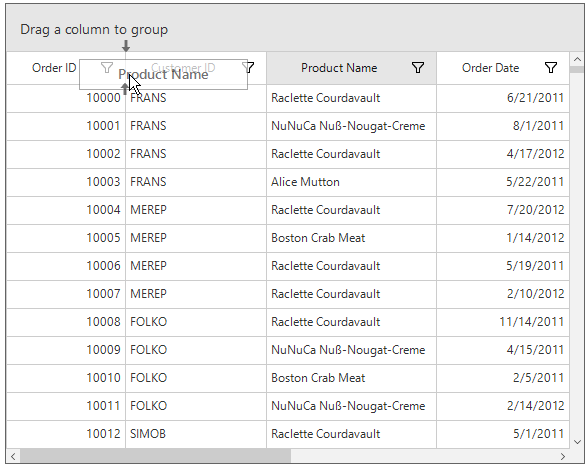
The drag and drop operation for particular column can be enabled or disabled using the AllowDragging property.
sfDataGrid.Columns[0].AllowDragging = false;sfDataGrid.Columns(0).AllowDragging = FalseDisable Column Reordering
The ColumnDragging event occurs when start dragging the column header. The dragging operation of the particular column can canceled by handling the ColumnDragging event. ColumnDraggingEventArgs of ColumnDragging event provides information about the column triggered this event.
Cancel Dragging Operation
SfDataGrid allow to cancel dragging operation for particular column by handling the ColumnDragging event when the e.Reason is ColumnDraggingAction.DragStarting.
sfDataGrid.ColumnDragging += sfDataGrid_ColumnDragging;
void sfDataGrid_ColumnDragging(object sender, Syncfusion.WinForms.DataGrid.Events.ColumnDraggingEventArgs e)
{
var column = sfDataGrid.Columns[e.From];
if (column.MappingName == "OrderID" && e.Reason == ColumnDraggingAction.DragStarting)
{
e.Cancel = true;
}
}AddHandler sfDataGrid.ColumnDragging, AddressOf sfDataGrid_ColumnDragging
Private Sub sfDataGrid_ColumnDragging(ByVal sender As Object, ByVal e As Syncfusion.WinForms.DataGrid.Events.ColumnDraggingEventArgs)
Dim column = sfDataGrid.Columns(e.From)
If column.MappingName = "OrderID" AndAlso e.Reason = ColumnDraggingAction.DragStarting Then
e.Cancel = True
End If
End SubCancel Column Reordering
SfDataGrid allow to cancel dropping a column at particular column by handling the ColumnDragging event with e.Reason is ColumnDraggingAction.Dropping.
sfDataGrid.ColumnDragging += sfDataGrid_ColumnDragging;
void sfDataGrid_ColumnDragging(object sender, Syncfusion.WinForms.DataGrid.Events.ColumnDraggingEventArgs e)
{
if (e.Reason == ColumnDraggingAction.Dropping)
{
var column = sfDataGrid.Columns[e.To];
if (column.MappingName == "ProductName")
{
e.Cancel = true;
}
}
}AddHandler sfDataGrid.ColumnDragging, AddressOf sfDataGrid_ColumnDragging
Private Sub sfDataGrid_ColumnDragging(ByVal sender As Object, ByVal e As Syncfusion.WinForms.DataGrid.Events.ColumnDraggingEventArgs)
If e.Reason = ColumnDraggingAction.Dropping Then
Dim column = sfDataGrid.Columns(e.To)
If column.MappingName = "ProductName" Then
e.Cancel = True
End If
End If
End SubDrag and Drop Customization
The drag-and-drop operations can be changed by overriding the virtual methods of ColumnDragDropController class and assigning it to SfDataGrid.ColumnDragDropController.
sfDataGrid.ColumnDragDropController = new CustomDragAndDropController(sfDataGrid.TableControl, sfDataGrid.GroupPanel);
public class CustomDragAndDropController : ColumnDragDropController
{
public CustomDragAndDropController(TableControl tableControl, GroupPanel groupPanel)
: base(tableControl, groupPanel)
{
}
protected override bool CanShowPopup(GridColumn column)
{
if (column.MappingName == "UnitPrice")
return false;
return base.CanShowPopup(column);
}
protected override void PopupDroppedOnHeaderRow(int oldIndex, int newIndex)
{
if (newIndex == 0)
return;
base.PopupDroppedOnHeaderRow(oldIndex, newIndex);
}
protected override void PopupDroppedOnGroupDropArea(GridColumn draggingColumn, MouseEventArgs e)
{
if (draggingColumn.MappingName == "OrderID")
return;
base.PopupDroppedOnGroupDropArea(draggingColumn, e);
}
}sfDataGrid.ColumnDragDropController = New CustomDragAndDropController(sfDataGrid.TableControl, sfDataGrid.GroupPanel)
public class CustomDragAndDropController : ColumnDragDropController
public CustomDragAndDropController(TableControl tableControl, GroupPanel groupPanel)
MyBase.New(tableControl, groupPanel)
protected override Boolean CanShowPopup(GridColumn column)
If column.MappingName = "UnitPrice" Then
Return False
End If
Return MyBase.CanShowPopup(column)
protected override void PopupDroppedOnHeaderRow(Integer oldIndex, Integer newIndex)
If newIndex = 0 Then
Return
End If
MyBase.PopupDroppedOnHeaderRow(oldIndex, newIndex)
protected override void PopupDroppedOnGroupDropArea(GridColumn draggingColumn, MouseEventArgs e)
If draggingColumn.MappingName = "OrderID" Then
Return
End If
MyBase.PopupDroppedOnGroupDropArea(draggingColumn, e)Disabling Drag and Drop between Frozen and Non-frozen Columns
By default, the columns re-ordering performed between any column regions of columns. The dropping action can cancel between the frozen and non-frozen columns by handling SfDataGrid.ColumnDragging event.
sfDataGrid.ColumnDragging += sfDataGrid_ColumnDragging;
void sfDataGrid_ColumnDragging(object sender, Syncfusion.WinForms.DataGrid.Events.ColumnDraggingEventArgs e)
{
if (e.Reason == ColumnDraggingAction.Dropping)
{
var frozenColIndex = this.sfDataGrid.FrozenColumnCount + this.sfDataGrid.TableControl.ResolveToStartColumnIndex();
if (e.From < frozenColIndex && e.To > frozenColIndex - 1)
e.Cancel = true;
if (e.From > frozenColIndex && e.To < frozenColIndex || (e.From == frozenColIndex && e.To < frozenColIndex))
e.Cancel = true;
}
}AddHandler sfDataGrid.ColumnDragging, AddressOf sfDataGrid_ColumnDragging
Private Sub sfDataGrid_ColumnDragging(ByVal sender As Object, ByVal e As Syncfusion.WinForms.DataGrid.Events.ColumnDraggingEventArgs)
If e.Reason = ColumnDraggingAction.Dropping Then
Dim frozenColIndex = Me.sfDataGrid.FrozenColumnCount + Me.sfDataGrid.TableControl.ResolveToStartColumnIndex()
If e.From < frozenColIndex AndAlso e.To > frozenColIndex - 1 Then
e.Cancel = True
End If
If e.From > frozenColIndex AndAlso e.To < frozenColIndex OrElse (e.From Is frozenColIndex AndAlso e.To < frozenColIndex) Then
e.Cancel = True
End If
End If
End SubNOTE
FrozenColumnCountandFooterColumnCountshould be lesser than the number of columns that can be displayed in view.
Stacked Headers
SfDataGrid supports additional unbound header rows known as StackedHeaderRows that span across the DataGrid columns using StackedHeaderRows. SfDataGrid allows to group one or more columns under each stacked header. Each StackedHeaderRow contains the StackedColumns where each StackedColumn contains a number of child columns.
StackedColumn.ChildColumns property returns the columns which are grouped under the stacked header row. StackedColumn.HeaderText returns the text that displays in stacked header row.
Adding Stacked header
The stacked headers can be added by using the below steps,
-
Create an object of
StackedHeaderRowfor adding stacked columns. -
Add the columns using
ChildColumnsproperty ofStackedColumn. -
Add the
StackedColumntoStackedColumnscollection. -
Finally add the
StackedHeaderRowtoStackedHeaderRowscollection of the SfDataGrid.
//Creating object for a stacked header row.
var stackedHeaderRow1 = new StackedHeaderRow();
//Adding stacked column to stacked columns collection available in stacked header row object.
stackedHeaderRow1.StackedColumns.Add(new StackedColumn() { ChildColumns = "OrderID,OrderDate", HeaderText = "Order Details" });
stackedHeaderRow1.StackedColumns.Add(new StackedColumn() { ChildColumns = "CustomerID,ContactNumber,", HeaderText = "Customer Details" });
stackedHeaderRow1.StackedColumns.Add(new StackedColumn() { ChildColumns = "ProductName,Quantity,UnitPrice,ShipCountry", HeaderText = "Product Details" });
//Adding stacked header row object to stacked header row collection available in SfDataGrid.
sfDataGrid.StackedHeaderRows.Add(stackedHeaderRow1);'Creating object for a stacked header row.
Dim stackedHeaderRow1 = New StackedHeaderRow()
'Adding stacked column to stacked columns collection available in stacked header row object.
stackedHeaderRow1.StackedColumns.Add(New StackedColumn() With {.ChildColumns = "OrderID,OrderDate", .HeaderText = "Order Details"})
stackedHeaderRow1.StackedColumns.Add(New StackedColumn() With {.ChildColumns = "CustomerID,ContactNumber,", .HeaderText = "Customer Details"})
stackedHeaderRow1.StackedColumns.Add(New StackedColumn() With {.ChildColumns = "ProductName,Quantity,UnitPrice,ShipCountry", .HeaderText = "Product Details"})
'Adding stacked header row object to stacked header row collection available in SfDataGrid.
sfDataGrid.StackedHeaderRows.Add(stackedHeaderRow1)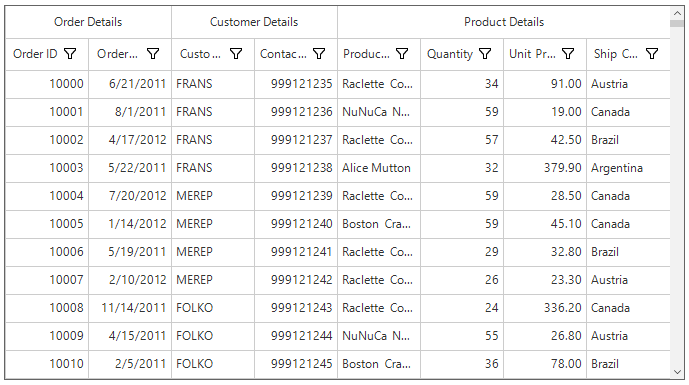
Adding Child Columns
SfDataGrid allows to add the child columns in a particular stacked header directly.
//Previous Child columns.
string previousChild = this.sfDataGrid.StackedHeaderRows[0].StackedColumns[0].ChildColumns;
//Adding ChildColumns to stacked header rows with additional child column.
this.sfDataGrid.StackedHeaderRows[0].StackedColumns[0].ChildColumns = previousChild + ",CustomerID";'Previous Child columns.
Dim previousChild As String = Me.sfDataGrid.StackedHeaderRows(0).StackedColumns(0).ChildColumns
'Adding ChildColumns to stacked header rows with additional child column.
Me.sfDataGrid.StackedHeaderRows(0).StackedColumns(0).ChildColumns = previousChild & ",CustomerID"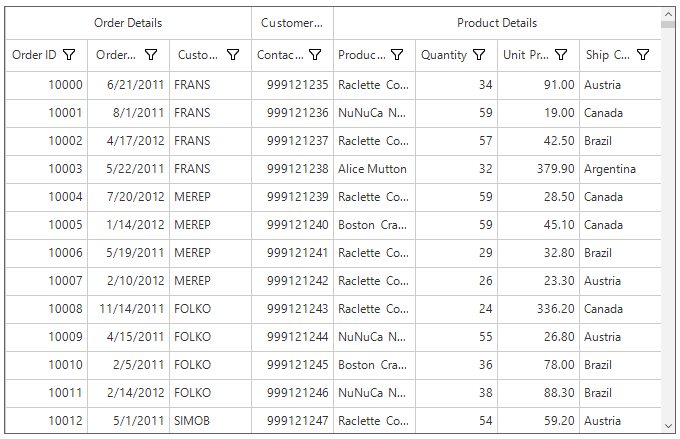
Removing Child Columns
SfDataGrid allows to remove the child columns from particular stacked header directly.
//Removing ChildColumns from the stacked header row.
var removingColumns = this.sfDataGrid.StackedHeaderRows[0].StackedColumns[0].ChildColumns.Split(',').ToList<string>();
string childColumns = string.Empty;
foreach (var stackedColumnName in removingColumns.ToList())
{
if (stackedColumnName.Equals("OrderID"))
{
removingColumns.Remove(stackedColumnName);
}
else
childColumns = childColumns + stackedColumnName + ",";
}
this.sfDataGrid.StackedHeaderRows[0].StackedColumns[0].ChildColumns = childColumns;'Removing ChildColumns from the stacked header row.
Dim removingColumns = Me.sfDataGrid.StackedHeaderRows(0).StackedColumns(0).ChildColumns.Split(","c).ToList(Of String)()
Dim childColumns As String = String.Empty
For Each stackedColumnName In removingColumns.ToList()
If stackedColumnName.Equals("OrderID") Then
removingColumns.Remove(stackedColumnName)
Else
childColumns = childColumns & stackedColumnName & ","
End If
Next stackedColumnName
Me.sfDataGrid.StackedHeaderRows(0).StackedColumns(0).ChildColumns = childColumns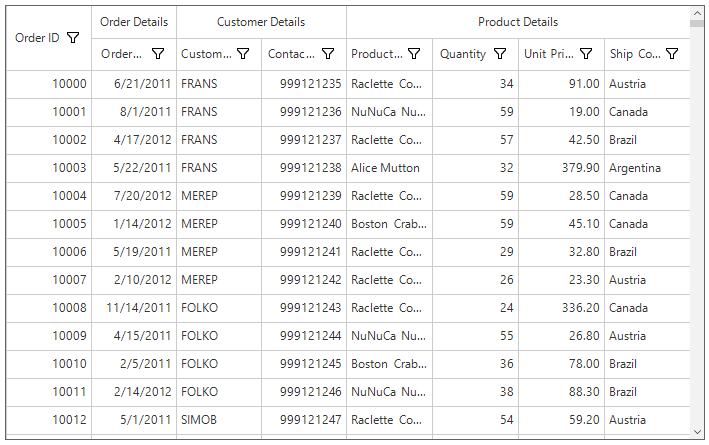
Multi Stacked Headers
Multiple stacked headers can be added to SfDataGrid by adding the required number of StackedHeaderRow to SfDataGrid.StackedHeaderRowsproperty.
//Creating instance for StackedHeaderRow
StackedHeaderRow stackedHeaderRow1 = new StackedHeaderRow();
StackedHeaderRow stackedHeaderRow2 = new StackedHeaderRow();
//Adding columns to StackedColumns collection to StackedHeaderRow object.
stackedHeaderRow1.StackedColumns.Add(new StackedColumn() { ChildColumns = "OrderID,CustomerID,ContactNumber,OrderDate,ProductName,Quantity", HeaderText = "Sales Details" });
stackedHeaderRow2.StackedColumns.Add(new StackedColumn() { ChildColumns = "OrderID", HeaderText = "Order Details" });
stackedHeaderRow2.StackedColumns.Add(new StackedColumn() { ChildColumns = "CustomerID,ContactNumber", HeaderText = "Customer Details" });
stackedHeaderRow2.StackedColumns.Add(new StackedColumn() { ChildColumns = "OrderDate,ProductName,Quantity", HeaderText = "Product Details" });
//Adding StackedHeaderRow object to StackedHeaderRows collection of SfDatagrid.
this.sfDataGrid.StackedHeaderRows.Add(stackedHeaderRow1);
this.sfDataGrid.StackedHeaderRows.Add(stackedHeaderRow2);'Creating instance for StackedHeaderRow
Dim stackedHeaderRow1 As New StackedHeaderRow()
Dim stackedHeaderRow2 As New StackedHeaderRow()
'Adding columns to StackedColumns collection to StackedHeaderRow object.
stackedHeaderRow1.StackedColumns.Add(New StackedColumn() With {.ChildColumns = "OrderID,CustomerID,ContactNumber,OrderDate,ProductName,Quantity", .HeaderText = "Sales Details"})
stackedHeaderRow2.StackedColumns.Add(New StackedColumn() With {.ChildColumns = "OrderID", .HeaderText = "Order Details"})
stackedHeaderRow2.StackedColumns.Add(New StackedColumn() With {.ChildColumns = "CustomerID,ContactNumber", .HeaderText = "Customer Details"})
stackedHeaderRow2.StackedColumns.Add(New StackedColumn() With {.ChildColumns = "OrderDate,ProductName,Quantity", .HeaderText = "Product Details"})
'Adding StackedHeaderRow object to StackedHeaderRows collection of SfDatagrid.
Me.sfDataGrid.StackedHeaderRows.Add(stackedHeaderRow1)
Me.sfDataGrid.StackedHeaderRows.Add(stackedHeaderRow2)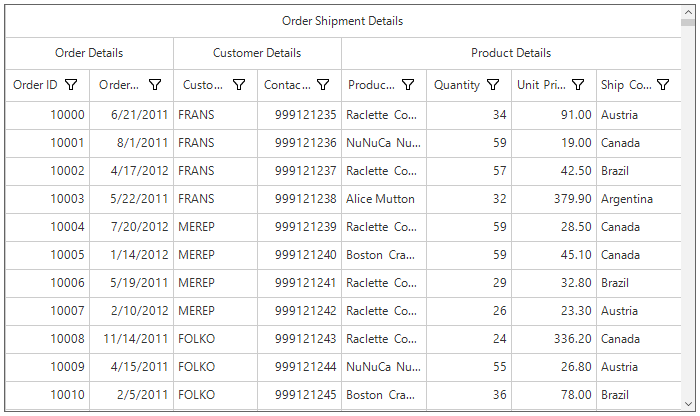
Appearance
Stacked Header Row Appearance
The appearance of stacked header row can be customized by setting the StackedHeaderStyle property. The StackedHeaderStyle property contains all the settings that are needed for the stacked header row appearance customization.
this.sfDataGrid.Style.StackedHeaderStyle.BackColor = Color.DarkCyan;
this.sfDataGrid.Style.StackedHeaderStyle.TextColor = Color.White;Me.sfDataGrid.Style.StackedHeaderStyle.BackColor = Color.DarkCyan
Me.sfDataGrid.Style.StackedHeaderStyle.TextColor = Color.White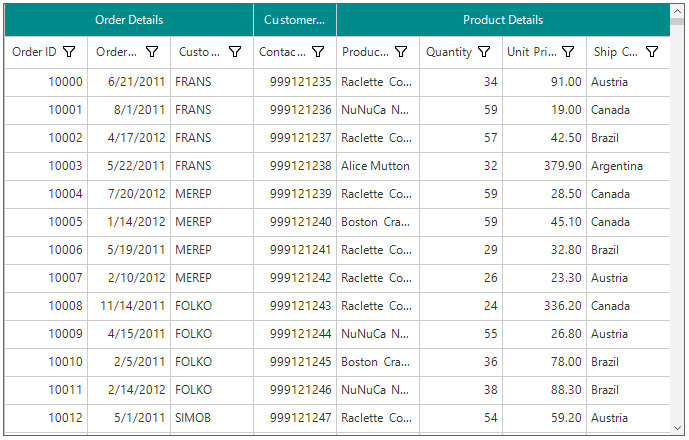
Changing the Stacked Header Appearance based on Column
An appearance of the stacked header row can be customized by using DrawCell event. SfDataGrid allow to check the row type for stacked header row by getting the property from (e.DataRow as DataRowBase).RowType of DrawCellEventArgs.
SfDataGrid allows to check the stacked column by its cell value which is available in DrawCellEventArgs and apply styling using ‘e.Style’ property of DrawCellEventArgs
this.sfDataGrid.DrawCell += SfDataGrid_DrawCell;
private void SfDataGrid_DrawCell(object sender, DrawCellEventArgs e)
{
if ((e.DataRow as DataRowBase).RowType == RowType.StackedHeaderRow)
{
if (e.CellValue == "Order Details")
{
e.Style.BackColor = Color.DarkCyan;
e.Style.TextColor = Color.White;
}
if (e.CellValue == "Customer Details")
{
e.Style.BackColor = Color.LightCyan;
}
if (e.CellValue == "Product Details")
{
e.Style.BackColor = Color.DarkGray;
e.Style.TextColor = Color.White;
}
}
}AddHandler sfDataGrid.DrawCell, AddressOf SfDataGrid_DrawCell
Private Sub SfDataGrid_DrawCell(ByVal sender As Object, ByVal e As DrawCellEventArgs)
If (TryCast(e.DataRow, DataRowBase)).RowType = RowType.StackedHeaderRow Then
If e.CellValue = "Order Details" Then
e.Style.BackColor = Color.DarkCyan
e.Style.TextColor = Color.White
End If
If e.CellValue = "Customer Details" Then
e.Style.BackColor = Color.LightCyan
End If
If e.CellValue = "Product Details" Then
e.Style.BackColor = Color.DarkGray
e.Style.TextColor = Color.White
End If
End If
End Sub
Font orientation for stacked headers
Font orientation of the stacked header cells can be set by using the StackedHeaderStyle.Font.Orientation property.
//Creating object for a stacked header row.
var stackedHeaderRow1 = new StackedHeaderRow();
//Adding stacked column to stacked columns collection available in stacked header row object.
stackedHeaderRow1.StackedColumns.Add(new StackedColumn() { ChildColumns = "OrderID,OrderDate", HeaderText = "Order" });
stackedHeaderRow1.StackedColumns.Add(new StackedColumn() { ChildColumns = "CustomerID,ContactNumber,", HeaderText = "Customer" });
stackedHeaderRow1.StackedColumns.Add(new StackedColumn() { ChildColumns = "ProductName,Quantity,UnitPrice,ShipCountry", HeaderText = "Product" });
//Adding stacked header row object to stacked header row collection available in SfDataGrid.
sfDataGrid1.StackedHeaderRows.Add(stackedHeaderRow1);
this.sfDataGrid1.HeaderRowHeight = 60;
//Set the font orientation for the stacked headers
this.sfDataGrid1.Style.StackedHeaderStyle.Font.Orientation = 45;'Creating object for a stacked header row.
Dim stackedHeaderRow1 = New StackedHeaderRow()
'Adding stacked column to stacked columns collection available in stacked header row object.
stackedHeaderRow1.StackedColumns.Add(New StackedColumn() With {.ChildColumns = "OrderID,OrderDate", .HeaderText = "Order"})
stackedHeaderRow1.StackedColumns.Add(New StackedColumn() With {.ChildColumns = "CustomerID,ContactNumber,", .HeaderText = "Customer"})
stackedHeaderRow1.StackedColumns.Add(New StackedColumn() With {.ChildColumns = "ProductName,Quantity,UnitPrice,ShipCountry", .HeaderText = "Product"})
'Adding stacked header row object to stacked header row collection available in SfDataGrid.
sfDataGrid1.StackedHeaderRows.Add(stackedHeaderRow1)
Me.sfDataGrid1.HeaderRowHeight = 60
'Set the font orientation for the stacked headers
Me.sfDataGrid1.Style.StackedHeaderStyle.Font.Orientation = 45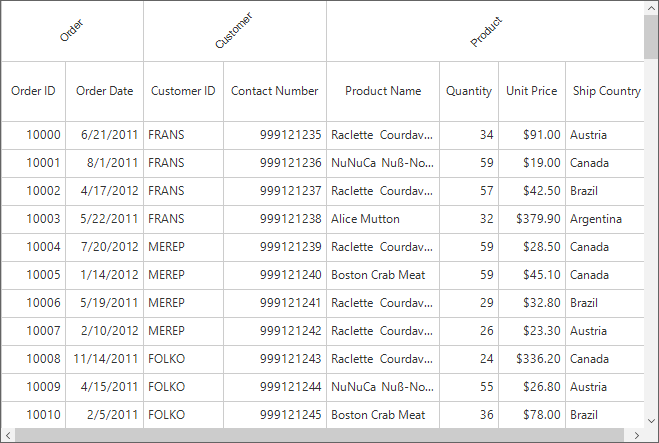
Column Sizing
SfDataGrid allows to set the column widths based on certain logic using SfDataGrid.AutoSizeColumnsMode or GridColumnBase.AutoSizeColumnsMode property. Below is the list of predefined column sizing options available.
| Name | Description |
|---|---|
| AllCells | Calculates the width of column based on header and cell contents. So, header and cell contents are not truncated. |
| AllCellsExceptHeader | Calculates the width of column based on cell contents. So, cell contents are not truncated. |
| AllCellsWithLastColumnFill | Applies width to all the columns except last column which is visible and sets the maximum between last column auto spacing width and remaining width to last column. |
| ColumnHeader | Calculates the width of column based on header content. So, header content is not truncated. |
| Fill | Divides the total width equally for columns. |
| LastColumnFill | Applies width to all the columns except last column which is visible and the remaining width from total width of SfDataGrid is set to last column. |
| None | No sizing. Default column width or defined width set to column. |
NOTE
AutoSizeColumnsModewill not work when the column width defined explicitly. AutoSizeCalculationMode calculates column width based on MinimumWidth and MaximumWidth properties of the column.
Below code, applies AutoSizeColumnsMode.Fill to equally set width for SfDataGrid.Columns.
OrderInfoCollection collection = new OrderInfoCollection();
sfDataGrid.DataSource = collection.OrdersListDetails;
sfDataGrid.AutoSizeColumnsMode = AutoSizeColumnsMode.Fill;Dim collection As New OrderInfoCollection()
sfDataGrid.DataSource = collection.OrdersListDetails
sfDataGrid.AutoSizeColumnsMode = AutoSizeColumnsMode.Fill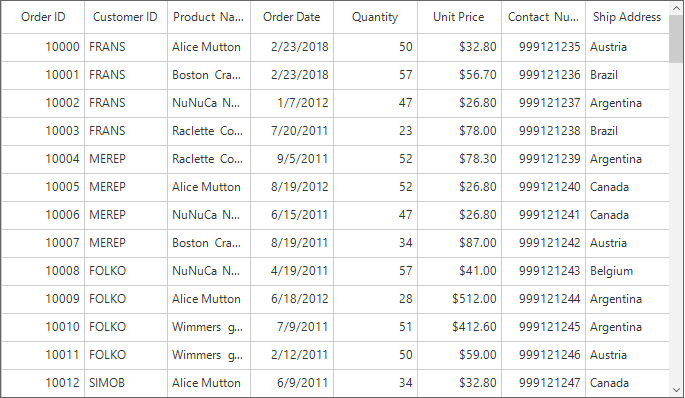
NOTE
The
GridColumnBase.AutoSizeColumnsModetakes higher priority than theSfDataGrid.AutoSizeColumnsMode.
Fill Remaining Width for any Column
While setting SfDataGrid.AutoSizeColumnsMode as LastColumnFill or AllCellsWithLastColumnFill remaining width is applied to last column. The remaining width to specific column can be applied by setting GridColumnBase.AutoSizeColumnsMode property as like below,
this.sfDataGrid.AutoSizeColumnsMode = AutoSizeColumnsMode.LastColumnFill;
this.sfDataGrid.Columns["ProductName"].AutoSizeColumnsMode = AutoSizeColumnsMode.LastColumnFill;Me.sfDataGrid.AutoSizeColumnsMode = AutoSizeColumnsMode.LastColumnFill
Me.sfDataGrid.Columns("ProductName").AutoSizeColumnsMode = AutoSizeColumnsMode.LastColumnFill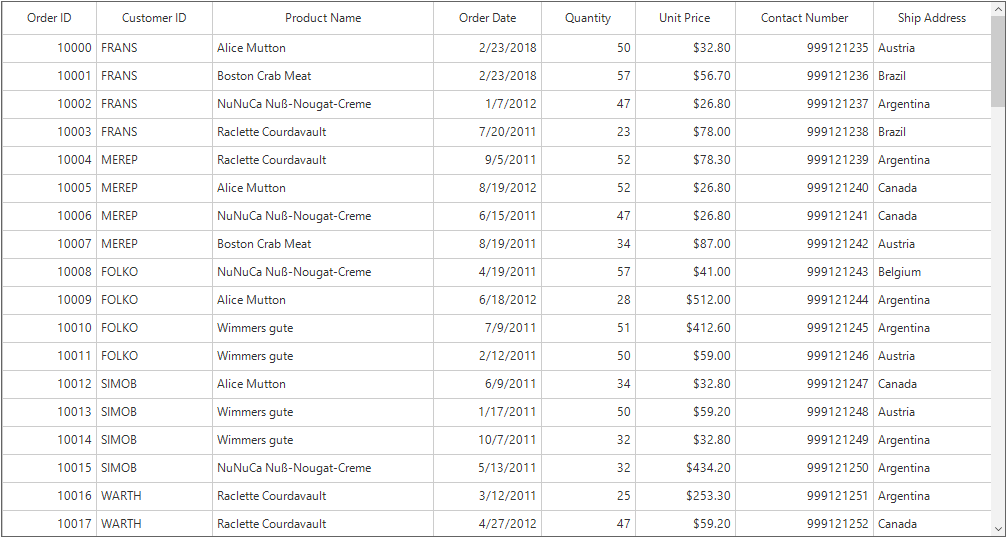
Auto Size based on String Length
By default, the auto size of the column is calculated based on the string width. To improve the performance of the column auto sizing, the column auto size calculation logic can be calculated based on the length of the values by using SfDataGrid.AutoSizeController.AutoSizeCalculationMode property.
The default is AutoSizeCalculationMode.Default which calculates size for all the cell’s formatted text. The columns can also be auto sized based on string length of the cell using the AutoSizeCalculationMode.SmartFit which calculates the size for the cell which has longest string.
this.sfDataGrid. AutoSizeController.AutoSizeCalculationMode = AutoSizeCalculationMode.SmartFit;
this.sfDataGrid.AutoSizeColumnsMode = AutoSizeColumnsMode.AllCells;Me.sfDataGrid.AutoSizeController.AutoSizeCalculationMode = AutoSizeCalculationMode.SmartFit
Me.sfDataGrid.AutoSizeColumnsMode = AutoSizeColumnsMode.AllCellsColumn Auto Sizing for Visible Rows
By default, the column auto size is calculated for the whole rows. The column auto size can be calculated for the visible rows only by using the AutoSizeController.AutoSizeRange property.
The default is AutoSizeRange.Table which considers all the records in the table for auto sizing. The columns can be auto sized considering only the visible rows using the AutoSizeRange.VisibleRows mode as like below.
this.sfDataGrid.AutoSizeController.AutoSizeRange = AutoSizeRange.VisibleRows;Me.sfDataGrid.AutoSizeController.AutoSizeRange = AutoSizeRange.VisibleRowsRefreshing ColumnSizer at Runtime
The auto column sizing can be refreshed at by calling SfDataGrid.AutoSizeController.Refresh method. The column auto width can be recalculated by calling the reset methods of AutoSizeController. The ResetAutoSizeWidthForAllColumns method reset widths to all columns. ResetAutoSizeWidth method reset the width to specific column.
NOTE
The column does not auto size its width automatically when the data of that column get changed.
For example, you can refresh all the column’s width based on the cell contents of newly added records at runtime.
var orderInfoCollection = this.sfDataGrid.DataSource as OrderInfoCollection;
orderInfoCollection.Orders.Add(new OrderInfo() { OrderID = 11, CustomerID = "BLFKI", ProductName = "Boston Crab Meat" });
this.sfDataGrid1.AutoSizeController.ResetAutoSizeWidthForAllColumns();
this.sfDataGrid1.AutoSizeController.Refresh();Dim orderInfoCollection = TryCast(Me.sfDataGrid.DataSource, OrderInfoCollection)
orderInfoCollection.Orders.Add(New OrderInfo() With {.OrderID = 11, .CustomerID = "BLFKI", .ProductName = "Boston Crab Meat"})
Me.sfDataGrid1.AutoSizeController.ResetAutoSizeWidthForAllColumns()
Me.sfDataGrid1.AutoSizeController.Refresh()Resetting Column Width to Apply AutoSizeColumnsMode
When the width of the column is explicitly defined or column is resized, column width is not changed based on AutoSizeColumnsMode. You can reset GridColumnBase.Width by setting -1 to apply column width based on column sizer.
foreach (var column in this.sfDataGrid.Columns)
{
if (column.Width != 0)
column.Width = -1;
}
this.sfDataGrid1.AutoSizeController.Refresh();For Each column In Me.sfDataGrid.Columns
If column.Width <> 0 Then
column.Width = -1
End If
Next column
Me.sfDataGrid1.AutoSizeController.Refresh()Customizing Built-in Column Sizing Logic
The column auto sizing operations of the SfDataGrid is processed in the AutoSizeController class. The column sizing operations can be customized by overriding AutoSizeController and set it to SfDataGrid.AutoSizeController property.
this.sfDataGrid.AutoSizeController = new CustomGridColumnSizer(this.sfDataGrid);
public class CustomGridColumnSizer : AutoSizeController
{
public CustomGridColumnSizer(SfDataGrid sfDataGrid)
: base(sfDataGrid)
{ }
// Calculate width for column when AutoSizeColumnsMode is AllCells.
protected override double CalculateAllCellsWidth(GridColumn column, bool isAllCells = false)
{
return base.CalculateAllCellsWidth(column, isAllCells);
}
// Calculate width for column when AutoSizeColumnsMode is ColumnHeader.
protected override int CalculateColumnHeaderWidth(GridColumn column, bool setWidth = true)
{
return base.CalculateColumnHeaderWidth(column, setWidth);
}
// Calculate width for column when AutoSizeColumnsMode is AllCellsExceptHeaderWidth.
protected override double CalculateAllCellsExceptHeaderWidth(GridColumn column, bool setWidth = true)
{
return base.CalculateAllCellsExceptHeaderWidth(column, setWidth);
}
}Me.sfDataGrid.AutoSizeController = New CustomGridColumnSizer(Me.sfDataGrid)
public class CustomGridColumnSizer : AutoSizeController
public CustomGridColumnSizer(SfDataGrid sfDataGrid)
MyBase.New(sfDataGrid)
' Calculate width for column when AutoSizeColumnsMode is AllCells.
protected override Double CalculateAllCellsWidth(GridColumn column, Boolean isAllCells = False)
Return MyBase.CalculateAllCellsWidth(column, isAllCells)
' Calculate width for column when AutoSizeColumnsMode is ColumnHeader.
protected override Integer CalculateColumnHeaderWidth(GridColumn column, Boolean setWidth = True)
Return MyBase.CalculateColumnHeaderWidth(column, setWidth)
' Calculate width for column when AutoSizeColumnsMode is AllCellsExceptHeaderWidth.
protected override Double CalculateAllCellsExceptHeaderWidth(GridColumn column, Boolean setWidth = True)
Return MyBase.CalculateAllCellsExceptHeaderWidth(column, setWidth)Custom Column Sizer with Ratio Support
The AutoSizeColumnsMode.Fill width calculation logic can be customized by overriding SetFillWidth method of AutoSizeController.
For example, the column width can be calculated with specified ratios instead of dividing equal width for all columns in AutoSizeColumnsMode.Fill calculation using the logic in below FillRatio class.
public static class FillRatio
{
// Returns the fill ratio for the column.
public static int GetColumnRatio(GridColumn column)
{
int i = 0;
switch (column.MappingName)
{
case "OrderID":
case "CustomerID":
case "Quantity":
case "ShipCountry":
i = 1;
break;
case "ProductName":
i = 3;
break;
case "OrderDate":
i = 2;
break;
}
return i;
}
}Public NotInheritable Class FillRatio
' Returns the fill ratio for the column.
Private Sub New()
End Sub
Public Shared Function GetColumnRatio(ByVal column As GridColumn) As Integer
Dim i As Integer = 0
Select Case column.MappingName
Case "OrderID", "CustomerID", "Quantity", "ShipCountry"
i = 1
Case "ProductName"
i = 3
Case "OrderDate"
i = 2
End Select
Return i
End Function
End ClassBelow code to define the fill width calculation based on the FillRatio.
public class CustomGridColumnSizer : AutoSizeController
{
public CustomGridColumnSizer(SfDataGrid sfDataGrid)
: base(sfDataGrid)
{ }
// Overridden to customize the AutoSizeColumnsMode.Fill logic.
protected override void SetFillWidth(double remainingColumnWidth, IEnumerable<GridColumn> remainingColumns)
{
var removedColumn = new List<GridColumn>();
var columns = remainingColumns.ToList();
var totalRemainingFillValue = remainingColumnWidth;
double removedWidth = 0;
bool isRemoved;
while (columns.Count > 0)
{
isRemoved = false;
removedWidth = 0;
var columnsCount = 0;
columns.ForEach((col) =>
{
columnsCount += FillRatio.GetColumnRatio(col);
});
double fillWidth = Math.Floor((totalRemainingFillValue / columnsCount));
var column = columns.First();
fillWidth *= FillRatio.GetColumnRatio(column);
double computedWidth = SetColumnWidth(column, (int)fillWidth);
if (fillWidth != computedWidth && fillWidth > 0)
{
isRemoved = true;
columns.Remove(column);
foreach (var remColumn in removedColumn)
{
if (!columns.Contains(remColumn))
{
removedWidth += remColumn.ActualWidth;
columns.Add(remColumn);
}
}
removedColumn.Clear();
totalRemainingFillValue += removedWidth;
}
totalRemainingFillValue = totalRemainingFillValue - computedWidth;
if (!isRemoved)
{
columns.Remove(column);
if (!removedColumn.Contains(column))
removedColumn.Add(column);
}
}
}
}Public Class CustomGridColumnSizer
Inherits AutoSizeController
Public Sub New(ByVal sfDataGrid As SfDataGrid)
MyBase.New(sfDataGrid)
End Sub
' Overridden to customize the AutoSizeColumnsMode.Fill logic.
Protected Overrides Sub SetFillWidth(ByVal remainingColumnWidth As Double, ByVal remainingColumns As IEnumerable(Of GridColumn))
Dim removedColumn = New List(Of GridColumn)()
Dim columns = remainingColumns.ToList()
Dim totalRemainingFillValue = remainingColumnWidth
Dim removedWidth As Double = 0
Dim isRemoved As Boolean
Do While columns.Count > 0
isRemoved = False
removedWidth = 0
Dim columnsCount = 0
For Each col As GridColumn In columns
columnsCount += FillRatio.GetColumnRatio(col)
Next
Dim fillWidth As Double = Math.Floor((totalRemainingFillValue / columnsCount))
Dim column = columns.First()
fillWidth *= FillRatio.GetColumnRatio(column)
Dim computedWidth As Double = SetColumnWidth(column, CInt(Fix(fillWidth)))
If fillWidth <> computedWidth AndAlso fillWidth > 0 Then
isRemoved = True
columns.Remove(column)
For Each remColumn In removedColumn
If Not columns.Contains(remColumn) Then
removedWidth += remColumn.ActualWidth
columns.Add(remColumn)
End If
Next remColumn
removedColumn.Clear()
totalRemainingFillValue += removedWidth
End If
totalRemainingFillValue = totalRemainingFillValue - computedWidth
If Not isRemoved Then
columns.Remove(column)
If Not removedColumn.Contains(column) Then
removedColumn.Add(column)
End If
End If
Loop
End Sub
End ClassBelow code to set the SfDataGrid.AutoSizeController to apply the custom logic for fill mode.
this.sfDataGrid.AutoGenerateColumns = false;
OrderInfoCollection orderInfoCollection = new OrderInfoCollection();
this.sfDataGrid.DataSource = orderInfoCollection.OrdersListDetails;
this.sfDataGrid.Columns.Add(new GridTextColumn() { MappingName = "OrderID" });
this.sfDataGrid.Columns.Add(new GridTextColumn() { MappingName = "CustomerID" });
this.sfDataGrid.Columns.Add(new GridTextColumn() { MappingName = "ProductName" });
this.sfDataGrid.Columns.Add(new GridDateTimeColumn() { MappingName = "OrderDate" });
this.sfDataGrid.Columns.Add(new GridNumericColumn() { MappingName = "Quantity" });
this.sfDataGrid.Columns.Add(new GridTextColumn() { MappingName = "ShipCountry" });
// Assigns the CustomGridColumnSizer to SfDataGrid.
this.sfDataGrid.AutoSizeController = new CustomGridColumnSizer(this.sfDataGrid);
this.sfDataGrid.AutoSizeColumnsMode = AutoSizeColumnsMode.Fill;Me.sfDataGrid.AutoGenerateColumns = False
Dim orderInfoCollection As New OrderInfoCollection()
Me.sfDataGrid.DataSource = orderInfoCollection.OrdersListDetails
Me.sfDataGrid.Columns.Add(New GridTextColumn() With {.MappingName = "OrderID"})
Me.sfDataGrid.Columns.Add(New GridTextColumn() With {.MappingName = "CustomerID"})
Me.sfDataGrid.Columns.Add(New GridTextColumn() With {.MappingName = "ProductName"})
Me.sfDataGrid.Columns.Add(New GridDateTimeColumn() With {.MappingName = "OrderDate"})
Me.sfDataGrid.Columns.Add(New GridNumericColumn() With {.MappingName = "Quantity"})
Me.sfDataGrid.Columns.Add(New GridTextColumn() With {.MappingName = "ShipCountry"})
' Assigns the CustomGridColumnSizer to SfDataGrid.
Me.sfDataGrid.AutoSizeController = New CustomGridColumnSizer(Me.sfDataGrid)
Me.sfDataGrid.AutoSizeColumnsMode = AutoSizeColumnsMode.Fill